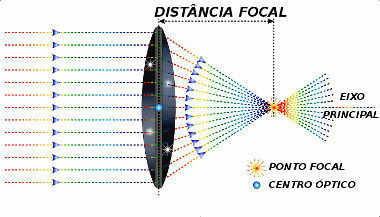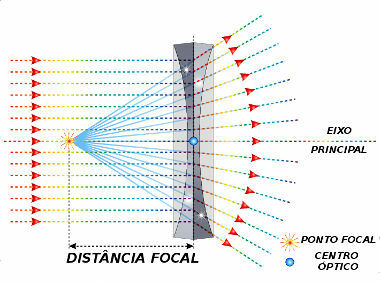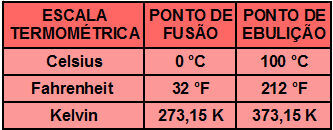The word vergence derives from the Latin expression vergent, which is related to turning, turning, bending or tilting. In physics, the vergence (V) determines the capacity of spherical lenses to converge or diverge light. Thus, the greater the deviation suffered by light rays when passing through a lens, the greater their verge.
Also called convergence, a vergence is defined by the inverse focus of a spherical lens.

O focus of a lens convergent corresponds to the distance between the optical center of the lens and the point where light rays are focused. The focus of the converging lenses will always be greater than zero.

O divergent lens focus corresponds to the distance between the optical center and the point from which the light apparently originates. The focus of divergent lenses will always be negative.

Because of the signals from the lens foci, the vergence of a converging lens will always be positive. The vergence of a divergent lens will be negative.
a person with myopia, for example, you must use divergent lenses to correct your vision problem. In the prescription prescribed by the ophthalmologist, the vergence value of these lenses appears with a negative sign. This indicates that these lenses must scatter light, that is, be
divergent.Vergence unit of measure
According to International System dand Units, the vergence is determined in diopters (di), a unit that corresponds to the inverse of the meter.
Do not stop now... There's more after the advertising ;)

Everyday, the verge of spectacle lenses, for example, is defined in degrees. However, the correct measurement unit for the light deflection capability of a lens is the diopter.
Example
(Acafe-SC) Diopter is a unit of measurement that measures the power of vergence (or refraction) of an optical system. It expresses the ability of a transparent medium to change the path of light. In optics, it is the unit of measurement of the power of a corrective lens (popularly known as degree).
In a consultation ten years ago, an ophthalmologist prescribed a person with glasses to correct myopia with a diverging 2.0 diopter lens. In a current consultation, a new prescription was made, with 2.5 diopters.
In relation to the previous statement, mark the correct alternative that completes the gaps in the following sentence.
In this ten-year period, the focal length of the lenses of these glasses was _______ in ______ cm.
a) reduced - 10
b) increased - 10
c) reduced - 0.5
d) increased - 0.5
By determining the vergence, the focal length of each lens at each epoch can be determined.
For the old 2-diopter lens, the focus module will be:

For the new lens, with 2.5 diopters, the module will be:

We can see that, after ten years, the focal length was reduced by 0.1 m (10 cm).
By Joab Silas
Graduated in Physics
Would you like to reference this text in a school or academic work? Look:
JUNIOR, Joab Silas da Silva. "What is vergence?"; Brazil School. Available in: https://brasilescola.uol.com.br/o-que-e/fisica/o-que-e-vergencia.htm. Accessed on June 29, 2021.


